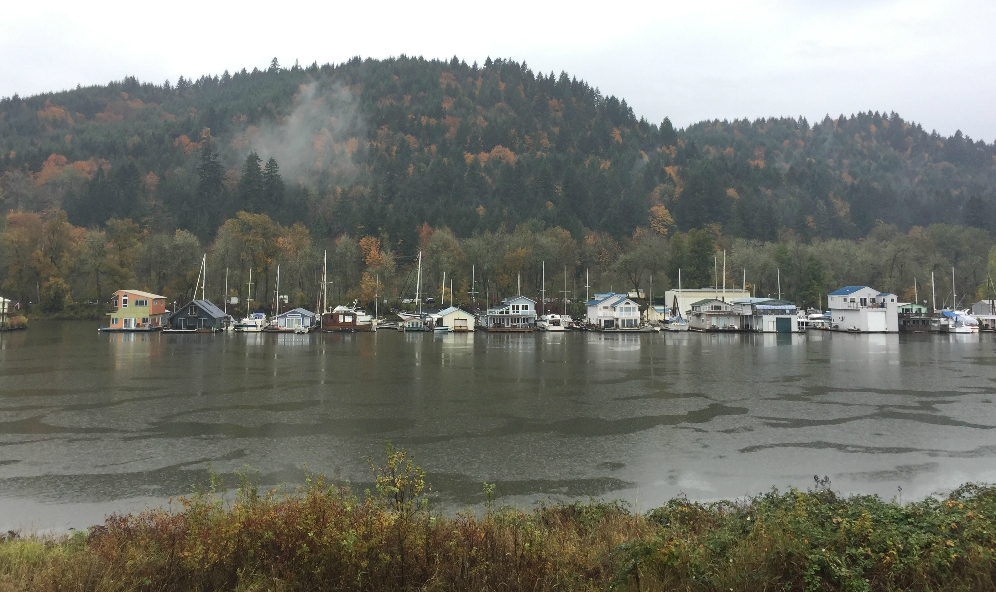At the Waterline, Brian Friesen’s debut novel and Ooligan Press’s last big release, hit stores this past May. It tells the story of a strange little community that quietly exists on the shores of Oregon’s most prominent river. Houseboat and sailboat communities dot the Columbia River, just miles from Portland’s urban center, sheltering thousands of wayward men and women who choose to live atop the water. Despite the Ooligan offices standing just a few blocks from the connecting Willamette river, most of its editors had no idea these kinds of communities existed.
When one thinks about the realities of creating entertainment, the production of books lags far behind its contemporaries in terms of risk and adventure. The actor films on location and the musician records across the world. Then there is the book editor, hunched over his or her MacBook©, living or dying on the authenticity of the author’s voice, yet feeling no pressure to go out and see for themselves.
At Ooligan Press, we have the benefit of being located in the heart of the region we serve as publishers. We’re firm believers in the value of bringing personal perspectives to the table as editors. As such, when production for At the Waterline was in full sway, the editing crew decided to take a field trip to one of the Portland area’s prominent waterborne communities: Sauvie Island.
Sauvie Island’s last official census was almost 20 years ago, so its current population is not certain, though almost certainly low. Despite being just a short drive from Portland, it is well off the grid by urban standards. The state government is far more interested in conducting wildlife and environmental surveys in the area, so the communities of people who live there are usually left alone. Its houseboat communities are a near-perfect approximation of Brian Friesen’s vision and gave the At the Waterline team a chance to explore the world they’d only seen in writing. I’ve collected some of the team’s favorite memories and ideas in order to share them here:
- “[My favorite part was] seeing the houseboat communities in person. All of the boats were very different and it was very cool to see them all lined up along the piers. It also helps you imagine how the characters in At the Waterline lived: you could see where there are community gathering spaces, and you see firsthand how small their living quarters are. It was raining the day we went, and it made us all think that when living on a boat in the PNW, where it does rain a lot, much of your time has to be spent below-deck . . . .”
—Emily Hagenberger (Editor)
“I know the marketing process was best helped through the field trips. When you’re reading a book, you’re just there to enjoy it, but to get other people to read it, you really have to connect to that part of it that makes it special. Visiting the settings for both books was really helpful in that venture.”
—Mackenzie Deater (Editor)
“My favorite part was doing the corn maze at the pumpkin patch. It was over an hour of wading through a river of mud and only Mackenzie was brave enough to do it with me. Doesn’t really have anything to do with the book, but she is the [incumbent] project manager, so . . . maybe a willingness to get messy is something innate to leaders of this team.”
—Cobi Lawson (Managing Editor)
The benefit of placing an editing team on location isn’t something that is readily apparent, as it is difficult to measure an increase in authenticity, quality, and design acuity during a production process that lasts more than a year. But if one were to observe an At the Waterline team meeting, they’d notice a certain camaraderie that can only come from a collective experience. They’d also hear the abundance of creative and extraordinary ideas that have gone into At The Waterline‘s production, from engaging marketing schemes involving riverside scavenger hunts to the creation of a companion adult coloring book (designed by the talented Riley Pittenger). A lot of big ideas are coming from that tiny team.
Perhaps most importantly, one would sense a reverence and understanding for the source material, the author’s vision, and the fascinating world of waterborne communities hidden in plain sight. Our team knows exactly what kind of story they’re presenting to the world. They’ve been there.

